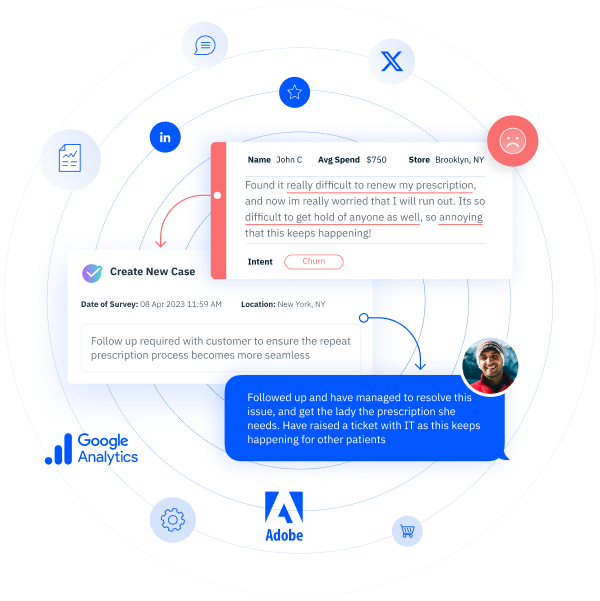Customer Experience in Healthcare: Transforming Patient Care
Customer experience in healthcare is about the journey patients undergo with your organization, from appointment scheduling to the quality of care and follow-up. Positive experiences build trust, foster loyalty, and lead to better health outcomes.
In today’s healthcare landscape, patient expectations are higher than ever. It’s not just about treating ailments anymore—it’s about delivering care that’s seamless, compassionate, and easy to access. So, what does it take to create an exceptional customer experience in healthcare? Discover the most important factors, common challenges, and top trends shaping the future of healthcare customer experience—and how you and your organization can lead the way.
What is Customer Experience in Healthcare?
We’ve all been a sick patient before, and we know that the experience can make or break how we feel about a healthcare provider. Customer experience in healthcare goes far beyond just scheduling appointments. It includes every touchpoint—whether it’s the way you’re greeted at the front desk, how well your concerns are listened to during an exam, or how smooth the follow-up process is. A positive experience doesn’t just create happy patients—it builds trust, fosters loyalty, and can even lead to better health outcomes. To sum it up, it’s about ensuring each step of the patient journey feels seamless, compassionate, and human.
What is Customer Experience Management in Healthcare?
Managing customer experience in healthcare involves actively monitoring and improving every touchpoint patients have with your organization. Think of it as building a feedback loop: you collect patient insights, analyze them, and take action to enhance the patient journey. Healthcare organizations that leverage tools like InMoment’s CX solutions can gather feedback in real time, identify problem areas, and streamline operations to make the experience as smooth as possible.
What is the Importance of Customer Experience in Healthcare?
In healthcare, the stakes are high. Patients aren’t just customers—they’re individuals often dealing with stress, illness, or pain. Their experience can have a profound impact not only on how they perceive your care but also on their overall well-being. It’s not just about providing excellent service to retain patients—it’s about being empathetic and making the entire process as easy and comforting as possible. This care extends beyond patients to their loved ones, making the experience smooth for everyone involved.
Most Important Factors in Healthcare Customer Experience
The patient experience in healthcare hinges on several important ingredients. Here are the top factors that make or break a great healthcare experience:
- Ease of Access: Make it simple for patients to book appointments, access test results, and communicate with your team.
- Wait Times: Long wait times can quickly sour an otherwise good experience. Reducing them shows respect for patients’ time.
- Clear Communication: From appointment reminders to treatment plans, patients need clarity and consistency at every step, such as balancing efficiency with delivering empathetic and thorough responses within healthcare contact centers.
- Staff Empathy: Friendly, compassionate care is key. A simple smile or a comforting word can make a huge difference.
- Personalized Care: Treating each patient as an individual, with tailored care, makes for a more meaningful experience.
- Facility: A clean, safe environment is a top concern for patients, especially for infection control and hygiene, but facility comfort, including ease of navigation and privacy, is also important.
Mastering these areas will set your healthcare practice apart and keep patients coming back.
What are Common CX Challenges in Healthcare?
Of course, healthcare comes with its unique set of challenges. For many organizations, it’s about balancing efficiency with compassion. Here are some of the most common CX hurdles healthcare providers face:
- Long Wait Times: Whether it’s waiting for an appointment or in the waiting room, delays are a top frustration for patients.
- Scheduling Issues: Limited availability or complicated booking processes can drive patients away.
- Bedside Manner: Healthcare professionals who lack empathy can create lasting negative impressions, even if the care is clinically sound.
These challenges vary depending on the type of provider. For example, hospitals may struggle with fragmented care coordination, dental offices often face appointment management issues, and pharmacies might have long lines or delays in prescription fulfillment. Addressing these issues head-on is the first step to improving CX.
How to Improve Customer Experience in Healthcare?
Improving healthcare customer experience doesn’t happen overnight, but there are actionable steps you can take:
- Streamline Scheduling: Use online booking systems to make it easier for patients to secure appointments at their convenience.
- Reduce Wait Times: Improve internal workflows to ensure patients aren’t left waiting unnecessarily.
- Enhance Communication: Keep patients informed with clear, compassionate communication, whether it’s before, during, or after treatment.
- Offer Training for Staff: Ongoing training on empathy and bedside manner ensures your team is offering the best possible patient care.
- Use Technology: Implement CX platforms like InMoment to monitor patient feedback, identify pain points, and optimize the patient journey in real time.

How to Create an Omnichannel Customer Experience in Healthcare
In today’s digital world, patients expect seamless experiences across multiple platforms. An omnichannel approach ensures that patients can interact with your organization through their preferred channels—whether it’s in-person, online, or via mobile. This could mean offering online appointment scheduling, a user-friendly mobile app, or telehealth services. Ensuring that patients have consistent, high-quality experiences across all touchpoints makes it easier for them to engage with your services and boosts overall satisfaction
Customer Experience Trends in Healthcare
As the healthcare landscape evolves, so do customer experience trends. Here’s what to expect:
- Telehealth Expansion: Virtual care isn’t going anywhere. As telehealth becomes more mainstream, expect continued improvements in remote care delivery.
- AI and Automation: AI is making its way into everything from appointment scheduling to treatment recommendations. It’s helping reduce wait times and improve efficiency.
- Personalized Healthcare: Data-driven insights allow healthcare providers to offer more personalized care, improving both outcomes and satisfaction.
- Natural Language Processing (NLP): Tools like NLP in healthcare are being used to analyze patient feedback at scale, allowing providers to address concerns faster and more effectively.
Improve Your Customer Experience in Healthcare with InMoment
Delivering a great healthcare customer experience takes more than just good intentions—it requires the right tools and strategies. With InMoment, you can capture real-time patient feedback, analyze it, and make data-driven decisions that improve every aspect of the patient journey. From reducing wait times to enhancing patient communication, our solutions are designed to help healthcare providers create the best possible experience for their patients.
Ready to start transforming your healthcare CX? Explore our healthcare reputation management and download our healthcare reputation report for insights on how to take your organization’s customer experience to the next level.




